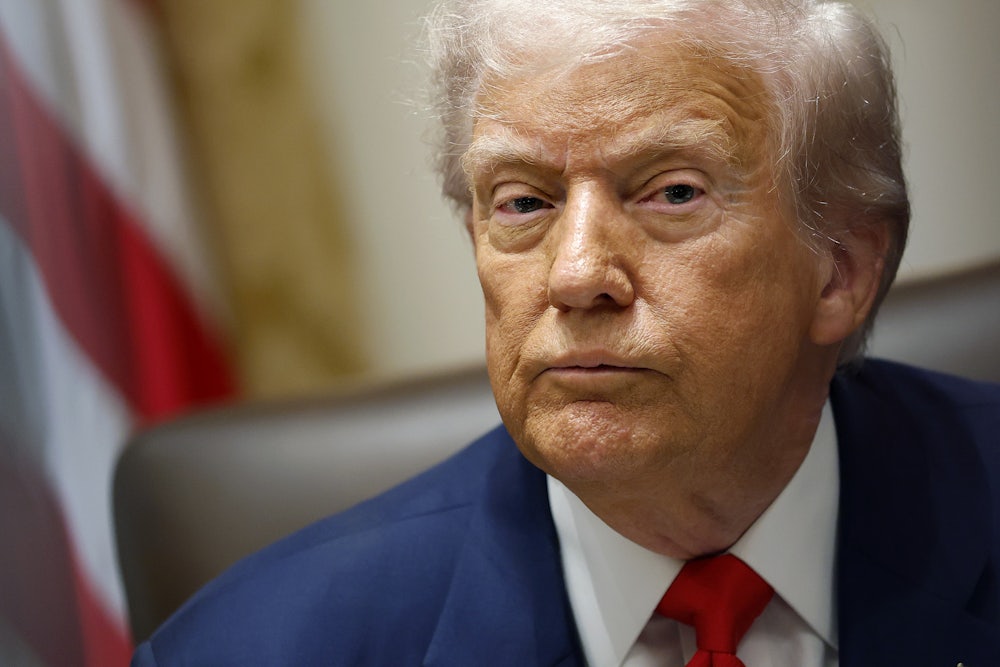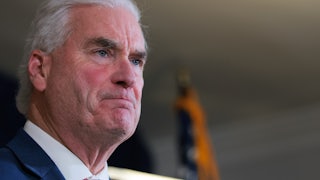While President Donald Trump continues to gamble with the U.S. economy—threatening tariffs, chickening out on tariffs, attempting to bully the Federal Reserve, interfering with the Bureau of Labor Statistics, laying off massive numbers of government employees, and deporting an even higher number of people, all while lining his own pockets—American workers are the ones who will pay the price.
Economists surveyed recently by The Wall Street Journal believe a labor market slowdown is ahead: They forecast the economy will create fewer than 50,000 jobs a month over the next year, down from earlier expectations. It’s just one sign of impending gloom: Mark Zandi of Moody’s Analytics published an analysis showing that 22 states are already in or close to a recession. Hiring has stalled; people are “hugging” their jobs. Fed Chair Jerome Powell said Tuesday that there are “significant downside risks” in the economy.
But as long the Fed keeps giving Trump and his investor-class cronies the interest rate cuts they’ve have been clamoring for—one last month, and almost certainly another one coming this month—and the stock market keeps soaring to all-time highs, Trump doesn’t care about the economic damage he’s causing. He probably relishes it, in fact, because he’s smashing yet another accomplishment of President Joe Biden.
Revisionist historians may try to say otherwise, but Biden—despite coming into an office during a once-in-a-century pandemic that killed more than a million Americans, spiked unemployment, and massively disrupted the global economy—had a fairly solid record when it came to his economic policies. Throughout his administration, Biden and his advisers had one North Star they followed: helping American workers. And in doing so, they left Trump with a robust labor market.
Even with the BLS downward revisions to the number of jobs added during Biden’s last year in office, his economy fundamentally added jobs, and wages rose from the bottom up throughout his term. More than that, Biden was a pro-labor president through and through. He was the first president to walk a picket line, joining a United Auto Workers strike in Michigan in 2023. The symbolism was important, but Biden also backed it up with policy: He strengthened the National Labor Relations Board and used regulations to prevent employers from misclassifying employees as independent contractors, protect all workers from heat stroke, and recover stolen wages.
Those pro-worker policies didn’t stop with the NLRB or Department of Labor. Biden’s Federal Trade Commission chair, Lina Khan, made a name for herself by trying to modernize antitrust policy. She went after corporations in Silicon Valley and beyond that were treating workers poorly, and banned noncompete policies. The administration also wove pro-worker policies into its congressional agenda. The Inflation Reduction Act, which supercharged the U.S. green energy economy, ensured that workers hired for American manufacturing jobs were well paid. Those policies, combined with the tight labor market after the Covid lockdowns ended, increased worker organizing and gave labor more bargaining power than it had seen in decades.
Despite photo ops trying to prove that he understands American workers, Trump has been hurrying to reverse nearly every pro-worker regulation enacted under Biden. He’s also laid off the federal workforce in such numbers that it will diminish the number of jobs available while growing the ranks of the unemployed, who will compete for jobs in a private market where businesses are now freed of many of Biden’s new rules.
Americans are feeling the tough job market. They’re worried they will lose their jobs and not at all confident they’ll be able to find a new one. CEOs are nervous too, meaning they’re less likely to increase hiring. Some employers, instead of investing in job creation, are betting on artificial intelligence. Young workers with the least experience are the most affected, but employers’ use of AI is making work harder for everyone because, it turns out, AI is bad at most jobs. (AI is mainly good at making rich people richer.)
Add the labor market woes to the affordability crisis and the Republicans’ slashes to the safety net, and Americans are in for a rough time ahead. The weakening economy means Trump will likely get more interest rate cuts, and the market will likely continue climbing on AI hype, but that won’t make borrowing or buying homes more achievable for people who’ve lost their job (or fear losing it).
Voters trusted Trump on the economy, at least more than they trusted Biden. Time and again on the campaign trail, Trump made hyperbolic promises like, “Starting on day one, we will end inflation and make America affordable again, to bring down the prices of all goods.” And: “Starting on day one, we will end inflation and make America affordable again. We’ll do that. We’ve got to bring it down.” And: “A vote for Trump means your groceries will be cheaper.”
As we now know, voters were wrong to believe Trump. It is day 270 of his presidency, and inflation continues to climb. Grocery prices are at record highs. Workers’ wallets are getting hammered, and we are only at the dawn of the Trump economy.






